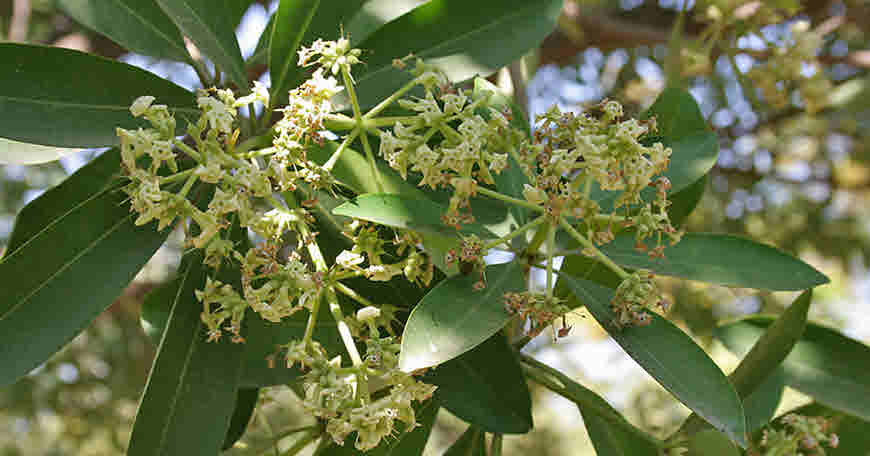
Saptparn
- December 2, 2020
- Posted by Dr. Vaidya Karanvir Singh
- 0 Comment(s)
Botanical Name: Alstonia scholaris.
Apocynaceae (Apocynaceae)
Name in English: Devil tree
Sanskrit-Saptaparna, Vishalatvakka, Shard, Suparnak, Gandhiparna, Saptachchhad, Chhatraparna, Munichchhad, Oddichada; Hindi-Satoun, Satna, Chhativan, Sativan; Urdu-Qasim (Kashim); Oriya-Chhotina, Kumbaro; Konkani-senthni-roku (Santhni-rooku), Kaduselle-roku (Kadusalle-rooku); Kannada-Haale, Bantale; Gujarati-Satavana (Saatvan); Tamil-Elilappalai, Maranallari; Telugu-Palagarud (Edakulaa pala), Edakula pala; Bengali-Chhatim, Chatwan; Nepali-Chatiwan; Marathi-Sattapan (Saatvin),
Saptaparni; Malayalam-Daivapala, Erilampala, Kumbaro.
Introduction
It is found in all the dry deciduous and verdant forests of India, in the western tropical Himalayas and in Assam and is planted as an ornamental plant on the roadsides or gardens. It has been enumerated in the Tarktaskandha, Kushtaghan, Udardprashamana, Shirovirechan and Sushrutasamhita’s Argavadhagdhana, Lakshadigana and Adhibhakahara ganas of Charaksamhita. In Charakasamhita, Saptaparna is mentioned in the treatment of leprosy, erysipelas and diuretics and in the Sushruta-Samhita as the constituent substances of various kalpas used in the treatment of diseases like ulcers, leprosy, pseudo-diabetes, chronic fever and aphasma.
It is about 12-18 m tall, large, everlasting, beautiful tree. Its letters are simple, numbered 4–7, in circular order at the end of the branches. Its flowers are white or cyan white. Its pods are 2–2 together, thin, cylindrical, 30–60 cm long, about 3 mm in diameter, circular and bunched.
Ayurvedic properties and effects
Saptaparna is bitter, astringent, hot, short, smooth, expectorant, aphrodisiac, heart, sarak (dastavar), madagandhi, ulcer and leprosy.
It is an antidote for shortness of breath, sores, colic, worms, leprosy, ulcers and blood defects.
Saptaparna is an anti-hypertensive factor, anti-cancer, anti-microbial, anti-toxemic and depressant of the central nervous system.
Its aphrodisiac is digestive, mild laxative, anthelmintic, antipyretic, purgative, laxative, appetite suppressant and tonic. And its letters and letters are anti-ulcer.
method of medicinal use
Putting Akshir (1-2 drops) of Saptaparna in the ear alleviates earache.
Dant krimi- If there is a dent between the teeth in the tooth-worm-worm tooth, then by filling jaggery or wax in it, by doing Dahan Karma, by filling Saptaparna Akshir, the toothache is alleviated.
Mukhapaka– Make decoction by mixing Sambhag Khas, Patol, Nagarmotha, Harad, Kutki, Mulethi, Amaltas and sandalwood in Mukhpak-Chhativan bark. Consumption of 10-30 ml decoction gives benefit in mouthwash.
Inhalation / cough- Mixing 1-2 parts of Satauna flower powder with Sambhag Pippali powder and consuming the flower with curd water (Mastu), inhalation with honey .
If phlegm and bile are also present in respiratory disease, then by mixing 1 gram Pippali powder and honey in 5 ml Saptaparna Patra-Swaras, drinking it gives quick benefit.
Germination – By making decoction of stem bark of Satauna and feeding it in the quantity of 15-30 ml, chronic gonorrhea is alleviated.
Liver Disorders– By making decoction of leaves of Satauna and consuming it in the quantity of 10-30 ml, there is benefit in liver disorders.
Gonorrhea: Grind the flowers of Kutaj, Kapitha, Rohitak, Vibhitak and Saptaparna and consume 1-2 grams of Kalk or the skin, leaves, roots, fruits, flowers etc. Consumption of decoction made from is beneficial in gonorrhea.
By making decoction of Sadrameh-Saptaparna and feeding it in the quantity of 15-30 ml, there is benefit in Sandrameh.
Make a decoction by mixing sambhag amaltas, ketki, cardamom, neem bark, karanj, kutki and gilloy in the bark of fossil urinary tract. Mixing honey in 10-30 ml decoction and feeding it gives benefit in stony urinary incontinence.
Breast purification is done by consuming sambhag sharangeshta (kakjangha, kakamachi or karanj), decoction made from saptaparna skin and ashwagandha (10-30 ml) or decoction made from guduchi and saptaparna.
Consumption of Mahapanchatikta Ghrit made methodically from Vatarakta-Saptaparna etc. is beneficial in Vatarakta, leprosy, leprosy, Raktarsha, Pandu, heart disease, Gulm, herpes, leprosy, goiter, measles, fever and chronic fever.
Grinding the bark of rheumatoid arthritis and applying it on the joints treats rheumatism and rheumatism.
The use of leprosy-saptaparna in bath, betel leaf, paste, powder etc. and consumption of proven oil ghee etc. from it is abundant in leprosy.
Applying the letter of Dushtavarna-Saptaparna on the affected area of leprosy, leprosy and Dushtavarna are planted.
Grinding and applying the bark of Uran-Chhativan with milk, ulcer is planted.
Applying Saptaparna Akshir gives benefit in rheumatic colic.
By making a solid decoction of hemoptysis-Chhativan (10-30 ml) and mixing 500 mg chopchini powder in it and consuming it with milk, hemorrhoids are alleviated.
Fever-chattivan bark, gilloy, vasa leaf, patol leaf, nagarmotha, bhoj leaf, khadir bark and end bark of neem are taken in equal quantity and made into decoction and fed in 15-30 ml, it gives relief in fever.
Make decoction by mixing sabhag gilloy, neem bark and dates in kaphaj-jwar-chativan bark. Mixing honey in 15-30 ml decoction and drinking it gives relief in phlegm fever.
प्रयोज्याङ्ग : पत्र, पुष्प एवं काण्ड छाल।
मात्रा : क्वाथ 15-30 मिली। स्वरस 10 मिली या चिकित्सक के परामर्शानुसार।

Dr. Vaidya Karanvir Singh is the younger Vaidya in Chandigarh Ayurved & Panchakarma Centre. He is the fourth generation in his family who is practicing as a general consultant in Ayurved & Panchakarma treatment at Chandigarh. In his practice, he had treated more than 1 Lakh Plus patients worldwide.

